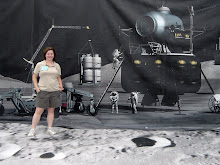Yikes. Here I am, trying to cram in all the work I have to do before leaving for Antarctica this Saturday, and the darn people out there get me talking about my favorite topic, the Moon.
"Riddle me this Science Girl: Does the moon have magnetic fields? I read somewhere that one problem with putting an outpost on the moon will be shielding astronauts from radiation. Is this true? I also read that future lunar missions would be longer than the Apollo program, but that they would not run into lunar night. Does being on the surface of the moon during lunar night bring about special problems for astronauts and jet setting planetary scientists? I hate to bring up the whole digging thing again, but what about putting in a subterranean bunker? I am just curious; after all, the new JB movie is out and "Moonraker" was one of my favorites! Are there natural caves on the moon? What about unnatural ones?"
The Moon doesn't have its own magnetic field like the Earth does. The Earth's magnetic field comes (very basically) from its spinning liquid core. No spinning liquid core in the Moon = no magnetic field. There are some rocks on the lunar surface that are magnetized though - these might have been magnetized by large, ancient impact events in some weird way of physics I won't even try to get into. Anyway, the upshot is that the Apollo astronauts were very lucky. They received low-level doses of radiation during their sorties, which is entirely recoverable, but by pure luck, did not encounter a solar flare that would have really dosed them. Now that we understand both the lunar radiation environment and the effects of radiation on humans better, you can bet there's a lot more work going into how to deal with this issue.
I have a great T-shirt that says, "I'm taking a lunar day off." Would be nice! A lunar day is a month long - the time it takes from full moon (which would be high noon if you stood on the near side) to full moon. So if you're on the surface, you've got pretty much 2 weeks of sunlight and 2 weeks of darkness. On the Earth, our atmosphere does a lot to keep our temperatures even. Think of cloudy nights that are warmer than clear nights, or the fact that when you're in the desert, the days can be very hot but the nights a lot colder because of the clear dry air. On the Moon, there's no atmosphere, so you've got the sun beating down on you during the day (surface temperature +100C) and absolute darkness at night (surface temperature -150C). So whether you plan your surface sortie during the day or the night, you have some extreme temperatures to deal with. It would be extra difficult to try to plan for both extremes during a single sortie.
What can you do to protect against both radiation and temperature extremes? A subsurface habitat will have a constant temperature equal to the Moon's mean surface temperature (-23°C) and protect against radiation and solar flares. People have speculated on how to construct these kinds of things for decades, and some people want to build habitats in lava tubes, the only kind of natural cave on the Moon. But don't expect to see them anytime soon. Excavating and building subsurface modules are the kinds of incredibly expensive architechture you'd be looking at for permanent bases, not for sorties like we're currently planning.
Subscribe to:
Post Comments (Atom)

No comments:
Post a Comment